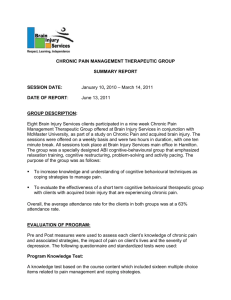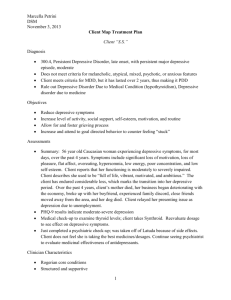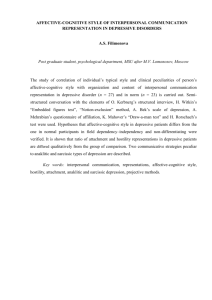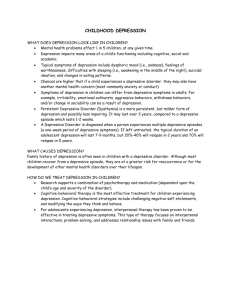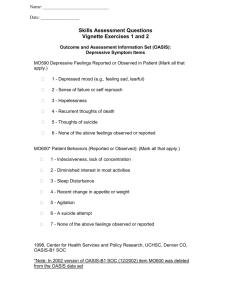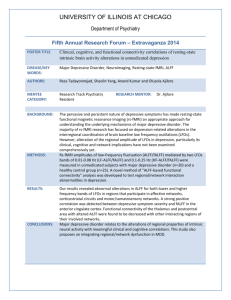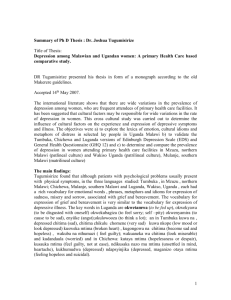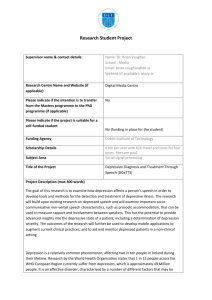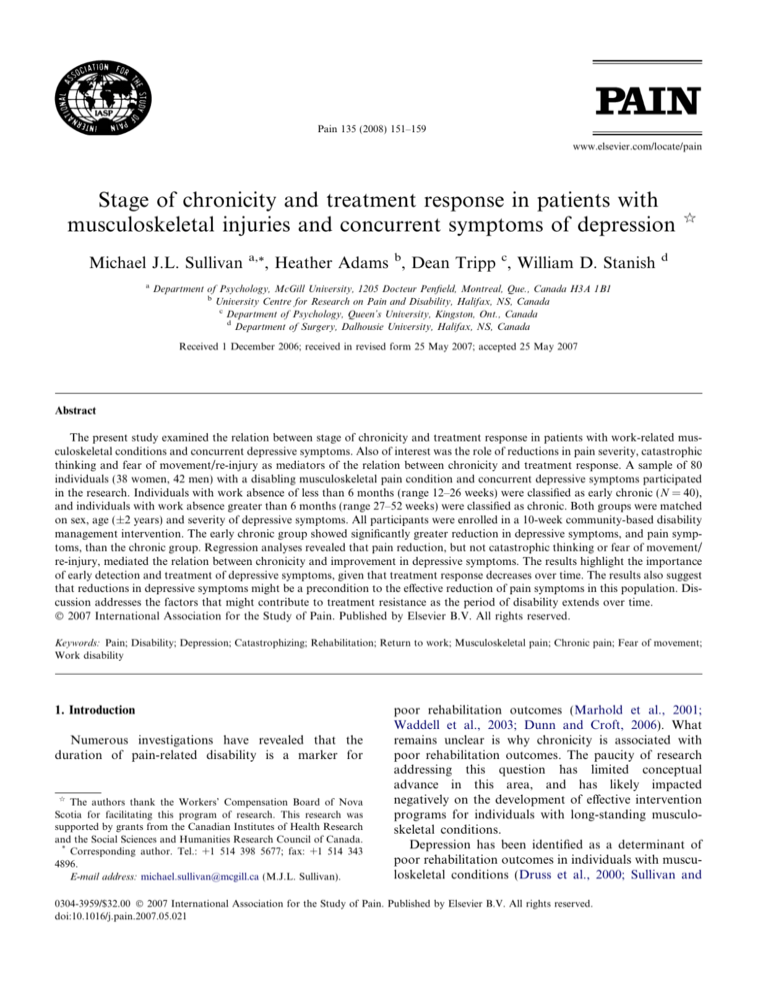
Pain 135 (2008) 151–159
www.elsevier.com/locate/pain
Stage of chronicity and treatment response in patients with
musculoskeletal injuries and concurrent symptoms of depression
Michael J.L. Sullivan
a
a,*
,
Heather Adams b, Dean Tripp c, William D. Stanish
q
d
Department of Psychology, McGill University, 1205 Docteur Penfield, Montreal, Que., Canada H3A 1B1
b
University Centre for Research on Pain and Disability, Halifax, NS, Canada
c
Department of Psychology, Queen’s University, Kingston, Ont., Canada
d
Department of Surgery, Dalhousie University, Halifax, NS, Canada
Received 1 December 2006; received in revised form 25 May 2007; accepted 25 May 2007
Abstract
The present study examined the relation between stage of chronicity and treatment response in patients with work-related musculoskeletal conditions and concurrent depressive symptoms. Also of interest was the role of reductions in pain severity, catastrophic
thinking and fear of movement/re-injury as mediators of the relation between chronicity and treatment response. A sample of 80
individuals (38 women, 42 men) with a disabling musculoskeletal pain condition and concurrent depressive symptoms participated
in the research. Individuals with work absence of less than 6 months (range 12–26 weeks) were classified as early chronic (N = 40),
and individuals with work absence greater than 6 months (range 27–52 weeks) were classified as chronic. Both groups were matched
on sex, age (±2 years) and severity of depressive symptoms. All participants were enrolled in a 10-week community-based disability
management intervention. The early chronic group showed significantly greater reduction in depressive symptoms, and pain symptoms, than the chronic group. Regression analyses revealed that pain reduction, but not catastrophic thinking or fear of movement/
re-injury, mediated the relation between chronicity and improvement in depressive symptoms. The results highlight the importance
of early detection and treatment of depressive symptoms, given that treatment response decreases over time. The results also suggest
that reductions in depressive symptoms might be a precondition to the effective reduction of pain symptoms in this population. Discussion addresses the factors that might contribute to treatment resistance as the period of disability extends over time.
2007 International Association for the Study of Pain. Published by Elsevier B.V. All rights reserved.
Keywords: Pain; Disability; Depression; Catastrophizing; Rehabilitation; Return to work; Musculoskeletal pain; Chronic pain; Fear of movement;
Work disability
1. Introduction
Numerous investigations have revealed that the
duration of pain-related disability is a marker for
q
The authors thank the Workers’ Compensation Board of Nova
Scotia for facilitating this program of research. This research was
supported by grants from the Canadian Institutes of Health Research
and the Social Sciences and Humanities Research Council of Canada.
*
Corresponding author. Tel.: +1 514 398 5677; fax: +1 514 343
4896.
E-mail address: michael.sullivan@mcgill.ca (M.J.L. Sullivan).
poor rehabilitation outcomes (Marhold et al., 2001;
Waddell et al., 2003; Dunn and Croft, 2006). What
remains unclear is why chronicity is associated with
poor rehabilitation outcomes. The paucity of research
addressing this question has limited conceptual
advance in this area, and has likely impacted
negatively on the development of effective intervention
programs for individuals with long-standing musculoskeletal conditions.
Depression has been identified as a determinant of
poor rehabilitation outcomes in individuals with musculoskeletal conditions (Druss et al., 2000; Sullivan and
0304-3959/$32.00 2007 International Association for the Study of Pain. Published by Elsevier B.V. All rights reserved.
doi:10.1016/j.pain.2007.05.021
152
M.J.L. Sullivan et al. / Pain 135 (2008) 151–159
Stanish, 2003; Lotters et al., 2006; Sullivan et al., in
press). However, a reliable relation between depressive
symptom severity and the duration of pain-related
disability has not been observed (Campbell et al.,
2003; Sullivan et al., 2006). As such, the severity of
depressive symptoms is an unlikely candidate as a
variable underlying the relation between chronicity
and poor rehabilitation outcomes.
It is possible, however, that progressive treatment
resistance in depressive symptoms might account for
the relation between chronicity and poor rehabilitation
outcomes. For example, research has shown that treatment response to pharmacological and psychological
interventions for depression decreases as a function of
symptom duration (Sotsky et al., 1991; Hirshfeld
et al., 1998; Detke et al., 2004). It is possible that depressive symptoms might become more treatment resistant
as the duration of pain-related disability extends over
time. No research has yet to address the relation
between chronicity and treatment-related reductions in
depressive symptoms.
Diathesis-stress formulations have been invoked to
account for the relation between depression and painrelated outcomes (Banks and Kerns, 1996; Campbell
et al., 2003). These models suggest that depressive symptoms arise as a joint function of vulnerability factors and
vulnerability-relevant contextual factors. Proceeding
from a diathesis-stress formulation, treatment-related
reductions in depressive symptoms might be expected
to be determined in part by changes in vulnerability factors and changes in vulnerability-relevant contextual
factors (Banks and Kerns, 1996; Turk, 2002; Sullivan
et al., 2006). It is possible that vulnerability factors or
vulnerability-relevant contextual factors might also
become resistant to change over time and compromise
the magnitude of treatment effects on depressive
symptoms.
One objective of the present research was to assess
the relation between chronicity and rehabilitation
outcome in individuals with musculoskeletal conditions and concurrent depressive symptoms. Rehabilitation outcome was addressed in terms of reductions in
pain symptoms, reductions in symptoms of depression
and return to work. A second objective of this
research was to examine the role of changes in vulnerability factors and changes in vulnerability-relevant
contextual factors as mediators of the relation between
chronicity and depressive symptom reduction. The
second objective was intended to shed light on why
depressive symptoms might become treatment resistant
as the period of disability extends over time. On the
basis of previous research, pain catastrophizing
and fear of movement/re-injury were chosen as vulnerability factors and pain severity was chosen as a
vulnerability-relevant contextual factor (Sullivan
et al., 2006).
2. Methods
2.1. Participants
A sample of 80 individuals (38 women, 42 men) with a disabling musculoskeletal pain condition participated in the
research. All participants had sustained a work-related back
injury and were currently receiving WCB wage replacement
benefits. Individuals with work absence of less than 6 months
(range 12–26 weeks) were classified as early chronic (N = 40),
and individuals with work absence greater than 6 months
(range 27–52 weeks) were classified as chronic. Data were
drawn from a larger sample of patients enrolled in a community-based secondary prevention program and were matched
on sex, age (±2 years) and Beck Depression Inventory-II (Beck
et al., 1996) scores (±2). All participants had Beck Depression
Inventory-II scores of 16 or greater as a condition of participation in the treatment program. The mean age of the sample
was 40.4 years with a range of 25–58 years.
2.2. Procedure
Participants in this research were enrolled in the Pain-Disability Prevention (PDP) Program (Sullivan et al., 2005). The
PDP Program is a 10-week standardized intervention aimed
at minimizing psychological barriers to rehabilitation progress
in individuals suffering from painful musculoskeletal conditions. The patient attends weekly sessions with a psychologist
trained in the delivery of the PDP Program. This intervention
differs from traditional pain management programs with its
primary focus on the reduction of psychological barriers to
return-to-work. Activity structuring, activity planning, graded
activity involvement, cognitive restructuring and problemsolving are used as primary tools to reduce depressive symptoms and depression-related disability. The PDP Program
can best be conceptualized as a life-role reintegration intervention where the objective is to assist clients in resuming participation in life role activities, in spite of the fact that their pain
still persists. Standardized assessments of the PDP Program
include measures of pain severity, catastrophic thinking, fear
of movement/re-injury and depression completed at pre-treatment (Week 1), mid-treatment (Week 4) and post-treatment
(Week 9).
The PDP Program was provided by 21 psychologists who
were part of a regionally distributed network of communitybased practitioners in the province of Nova Scotia, Canada
(for more information on the PDP Program and the network
of providers, see www.pdp-pgap.com). The PDP Program
was provided as an addition to usual medical management
and physical therapy. The addition of the PDP Program to
traditional rehabilitation treatment is intended to establish
‘virtual’ multidisciplinary teams at the community-based level
(Sullivan et al., 2005). Community-based psychologists were
asked to forward copies of PDP Program assessment results
(identified only by claim number) to our research centre. The
PDP Program assessment results were then linked to WCB
administrative data. Due to constraints in the nature of data
that could be accessed from the files of the community-based
practitioners, information concerning mental health diagnoses
and symptom/treatment history was not available for analysis.
M.J.L. Sullivan et al. / Pain 135 (2008) 151–159
153
Approximately, half (N = 45) of participants in this study
were also part of the participant sample described in Sullivan et al. (2005). The present sample differs from that
described in Sullivan et al. (2005) in that a BDI-II score
greater than 16 was a condition of participation in the present study but was not a condition of participation in Sullivan et al. (2005).
to full time pre-injury employment or alternate employment,
and their claim was closed. All other participants were classified as not having returned to work.
2.3. Measures
Sample selection procedures provided matched groups
on age, sex and BDI-II scores. As expected there were significant differences in the duration of work absence, with
the early chronic group averaging 15.2 weeks of work disability and chronic group averaging 33.3 weeks of work
disability, t(78) = 10.6, p < .001. Early chronic and
chronic groups did not differ significantly on the use of
NSAIDs, v2 = 2.0, ns, opiates, v2 = .80, ns, hypnotics,
v2 = .28, ns, anxiolytics, v2 = 1.4, ns, low dose antidepressants, v2 = 2.8, ns, or therapeutic dose antidepressants, v2 = 1.2, ns (see Table 1).
2.3.1. Pain severity
The McGill Pain Questionnaire (MPQ; Melzack, 1975) was
used as a measure of pain severity. Respondents endorsed
adjectives that best described their pain experience. The Pain
Rating Index (PRI) is a weighted sum of all adjectives
endorsed, and has been shown to be a reliable and valid index
of an individual’s pain experience (Turk et al., 1985).
2.3.2. Depression
The Beck Depression Inventory-II (BDI; Beck et al., 1996)
was used to measure severity of depressive symptoms. The
BDI-II consists of 21 items describing various symptoms of
depression. Respondents endorsed phrases that best described
how they had been feeling during the past two weeks. The
BDI-II has been shown to be a reliable and valid index of
depressive symptoms in chronic pain patients (Sullivan and
Stanish, 2003; Vowles et al., 2004; Poole et al., 2006).
2.3.3. Catastrophizing
The Pain Catastrophizing Scale (PCS; Sullivan et al., 1995)
was used as a measure of catastrophic thinking related to pain.
Respondents rated the frequency with which they experienced
each of 13 different thoughts and feelings when in pain. The
PCS has been shown to have high internal consistency (coefficient alpha = .87), and to be associated with heightened pain,
pain behavior and disability (Sullivan et al., 2005).
2.3.4. Fear of movement/re-injury
The Tampa Scale for Kinesiophobia (TSK; Kori et al.,
1990) was used as a measure of fear of movement and re-injury
associated with pain. Respondents indicated their level of
agreement with each of 17 statements reflecting worries or concerns about the consequences of participating in physical activity. The TSK been shown to be internally reliable (coefficient
alpha = .77; Vlaeyen et al., 1995), and to be associated with
various indices of disability (George et al., 2003).
2.3.5. Medication use
Respondents were asked to indicate the different medications they had been prescribed for their symptoms. For the
purpose of the present study, the use of different classes of
medication was dichotomized as follows: NSAIDs (y/n), opiates (y/n), hypnotics (y/n), anxiolytics (y/n), low dose antidepressants (y/n), and therapeutic dose antidepressants (y/n).
2.3.6. Return to work
Return to work status was assessed 4 weeks following termination of the PDP Program. Return to work information
and claim status were obtained from WCB files. Participants
were classified as having returned to work if they had returned
3. Results
3.1. Sample characteristics
3.2. Rehabilitation outcomes
As expected, the early chronic and chronic groups
differed in terms of return-to-work rates. In the early
chronic group, 67% of participants returned to work,
compared to 37% in the chronic group, v2 = 7.2, p < .01.
The trajectory of recovery in depression scores for the
early chronic and chronic groups is shown in Fig. 1. A
two-way (Level of chronicity · Time of assessment)
repeated measures analysis of variance (ANOVA)
revealed a significant main effect for Time,
F(2, 156) = 22.6, p < .001. The main effect for Level of
chronicity did not attain statistical significance,
F(1, 78) = 3.2, p < .07. A significant interaction was also
obtained, F(2, 156) = 8.9, p < .001. Although both
groups were comparable on initial depression scores,
the response to treatment for the chronic group (13%
reduction in BDI-II scores) was more modest than for
Table 1
Sample characteristics at pre-treatment assessment
Stage of chronicity
Sample size
(Men/women)
Age (years)
Work absence
BDI-II-T1
NSAIDs
Opiates
Hypnotics
Anxiolytics
Low dose antidepressants
Therapeutic dose
antidepressants
Early chronic
Chronic
p
N = 40
21/19
40.1 (8.2)
15.2 weeks (7.3)
24.5 (8.1)
35
20
10
10
9
6
N = 40
21/19
41.0 (7.5)
33.3 weeks (7.8)
24.0 (6.8)
30
24
8
15
16
10
ns
ns
.001
ns
ns
ns
ns
ns
ns
ns
Note. BDI-II, Beck Depression Inventory-II. Scores on the BDI-II
were obtained at pre-treatment assessment. Numbers in parentheses
are standard deviations.
154
M.J.L. Sullivan et al. / Pain 135 (2008) 151–159
Fig. 1. Changes in depressive symptoms as function of level of
chronicity. BDI-II raw scores for participants in the early chronic and
chronic groups for assessments conducted pre-treatment (Week 1),
mid-treatment (Week 4) and treatment termination (Week 9).
the early chronic group (33% reduction in BDI-II
scores), p < .05.
Reductions in pain scores across the 10-week intervention program for the early chronic and chronic
groups are displayed in Fig. 2. A two-way (Level of
chronicity · Time of assessment) repeated measures
ANOVA on pain severity scores (MPQ-PRI) revealed
a significant main effect for Time, F(2, 156) = 8.6,
p < .001, and a significant interaction, F(2, 156) = 9.7,
p < .001. Tests of simple effects revealed that the early
chronic group obtained significantly lower MPQ scores
at Week 9 assessment, p < .05, but the two groups did
not differ significantly at Week 1 and Week 4 assessments. The early chronic group showed a moderate
decrease in pain severity through the course of the treatment program (23% decrease) while the chronic group
showed a slight increase in pain severity (4% increase).
3.3. Do changes in depression account for the relation
between chronicity and rehabilitation outcomes?
role of change in depression as a mediator of the relation
between chronicity and rehabilitation outcomes, change
scores (Week 1–Week 9) were computed for pain severity, and depression. Mediation is established when the
independent variable (e.g., level of chronicity) is associated with both the dependent variable (e.g., rehabilitation outcome) and the hypothesized mediator (e.g.,
change in depression) (Baron and Kenny, 1986). Complete mediation is established when the relation between
the independent and dependent variables is no longer
significant, after variance associated with the mediator
has been controlled. In order to be considered as a
potential mediator, a variable must show a significant
association with both independent and dependent variables (Holmbeck, 1997).
Change in BDI-II scores was significantly correlated
with change in pain, r = .44, p < .01. Furthermore, reduction in BDI-II scores was significantly greater for participants who returned to work (M(BDI-II T1–BDI-II T3) = 7.6;
SD = 5.7) than for participants who did not return to
work (M(BDI-II T1–BDI-II T3) = 2.6; SD = 9.8), t(78) =
2.8, p < .01. As such, the conditions for analysis of mediation for change in depressive symptoms, change in pain
severity, return to work and level of chronicity were met.
As shown in Table 2, the results of a logistic regression indicated that chronicity was a significant predictor
of return to work, Nagelkerke R2 = .12, p < .001. A second logistic regression was conducted where change in
depressive symptoms was entered in Step 1 of the analysis, and level of chronicity was entered in Step 2. The
proportion of variance accounted for by level of chronicity was reduced from 12% to 4%. Nevertheless, level
of chronicity significantly predicted return to work status even when controlling for change in depressive
symptoms. These results suggest that while change in
depressive symptoms is a significant determinant of
return to work, change in depressive symptoms only
Two important rehabilitation outcomes include pain
reduction and return to work. In order to examine the
Table 2
Logistic regression examining mediators of the relation between
chronicity and rehabilitation outcome (return to work)
Dependent variable =
Return to work
Dv2
R2change
OR
CI
Regression 1: chronicity and treatment response (return to work)
Step 1
Level of chronicity
7.3
.12
.28**
.11–.72
Regression 2: the mediating role of change in depression
Step 1
BDI-II-ch
7.6
.12
1.10**
Step 2
Level of chronicity
4.2
.04
.36*
Fig. 2. Changes in pain severity as function of level of chronicity.
MPQ-PRI raw scores for participants in the early chronic and chronic
groups for assessments conducted pre-treatment (Week 1), midtreatment (Week 4) and treatment termination (Week 9).
1.0–1.1
.14–.95
Note. N = 80. Dv2 = Nagelkerke R2; OR = Odds ratio; CI = 95th
percentile confidence interval.
*
p < .05.
**
p < .01.
M.J.L. Sullivan et al. / Pain 135 (2008) 151–159
Table 3
Regression analyses examining mediators of the relation between
chronicity and change in pain severity
Dependent variable
Change in MPQ-PRI
B
R2change
Fchange
p
Regression 1: chronicity and treatment response (reductions in pain)
Step 1
.18
17.8 (1, 78)
.001
Level of chronicity
.43**
Regression 2: the mediating role of change in depression scores
Step 1
.20
18.9 (1, 78)
BDI-II-ch
.34**
Step 2
Level of chronicity
.33**
.09
11.1 (1, 77)
.001
.001
Note. N = 80. Standardized Beta weights are from the final regression
equation.
**
p < .01.
partially mediates the relation between level of chronicity and return to work.
Hierarchical multiple regression analyses were conducted to examine the role of change in depressive
symptoms in mediating the relation between level of
chronicity and pain reduction. As shown in Table 3,
when level of chronicity was the only variable in the
analysis, it accounted for 18% of the variance in
change in pain symptoms, F(1, 78) = 17.8, p < .001.
In a second regression analysis, change in depressive
symptoms was entered in Step 1 of the analysis and
accounted for 20% of the variance in pain reduction,
F(1, 78) = 18.9, p < .001. When controlling for change
in depression, the Beta weight for level of chronicity
decreased from .43 to .33. Nevertheless, the contribution of level of chronicity to the prediction of pain
reduction remained significant. These results suggest
that change in depressive symptoms partially mediates
the relation between level of chronicity and pain
reduction.
3.4. Mediators of the relation between level of chronicity
and reductions in depressive symptoms
Table 4 shows the scores on measures of pain catastrophizing and fear of movement/re-injury at all three
test periods over the course of the treatment program
(Week 1, Week 4, Week 9). A two-way (Level of chronicity · Time of assessment) repeated measures
155
ANOVA on pain catastrophizing scores (PCS) yielded
main effects for Time, F(2, 156) = 33.3, p < .001, and
for Level of chronicity, F(1, 78) = 9.8, p < .01. The interaction term was not significant, F(2, 56) = .37, ns.
A two-way (Level of chronicity · Time of assessment)
repeated measures ANOVA on fear of movement/reinjury scores (TSK) revealed main effects for Level of
chronicity = 4.0, p < .05, Time,
F(2, 156) = 12.8
p < .001, and a significant interaction, F(2, 156) = 11.8,
p < .01. Tests of simple effects revealed that the early
chronic group obtained significantly lower TSK scores
at the final evaluation (Week 9) than the chronic group,
p < .05, but the two groups did not differ on TSK scores
on the first two evaluations (Week 1, Week 4).
Change scores (Week 9–Week 1) were computed for
pain catastrophizing and fear of movement/re-injury.
Table 5 presents the correlations among changes in pain,
depressive symptoms, pain catastrophizing and fear of
movement/re-injury. Changes in pain severity, pain
catastrophizing and fear of movement/re-injury were
significantly correlated with changes in depressive symptoms. As such, the conditions for analyses addressing
mediators of the relation between level of chronicity
and reductions in depressive symptoms were met.
As shown in Table 6, Level of chronicity was a significant predictor of change in depressive symptoms
(Regression 1: Beta .29, p < .01). When change in pain
severity was entered in the first step of Regression 2,
Level of chronicity was no longer a significant predictor
of change in depressive symptoms (Beta = .12, ns).
These results of this analysis indicate that change in pain
severity mediates the relation between level of chronicity
and reduction in depressive symptoms.
The results of Regression 3 revealed that a significant
proportion of the variance in change in depressive symptoms was accounted for by change in pain catastrophizing (Beta = .41, p < .001). However, Level of chronicity
(Beta = .26, p < .01) remained a significant predictor
of change in depressive symptoms even when controlling
for change in pain catastrophizing. These results indicate that pain catastrophizing does not mediate the relation between level of chronicity and reduction in
depressive symptoms.
The results of Regression 4 revealed that a significant
proportion of the variance in change in depression was
explained by change in fear of movement/re-injury,
Table 4
Scores on measures of pain catastrophizing and fear of movement/re-injury through the course of treatment
Stage of chronicity
Early chronic
PCS
TSK
Chronic
Week 1
Week 4
Week 9
Week 1
Week 4
Week 9
25.7 (10.4)
42.4 (8.8)
20.5 (12.8)
40.8 (8.5)
18.7 (14.2)
36.3 (9.7)
32.4 (8.5)
43.6 (6.8)
28.6 (9.5)
43.3 (8.0)
26.5 (11.1)
43.3 (8.7)
Note. PCS, Pain Catastrophizing Scale; TSK, Tampa Scale for Kinesiophobia. Numbers in parentheses are standard deviations.
156
M.J.L. Sullivan et al. / Pain 135 (2008) 151–159
Table 5
Correlations among changes in pain severity, pain catastrophizing and
fear of movement/re-injury
MPQ-ch
BDI-II-ch
PCS-ch
TSK-ch
MPQ-ch
BDI-II-ch
PCS-ch
.44**
.29**
.27*
.45**
.24*
.48**
Note. N = 80. Change scores were computed by subtracting scores
obtained at the Week 9 evaluation from the Week 1 evaluation.
* p < .05.
** p < .01.
when considered alone in the analysis, R2 = .05,
F(1, 78) = 4.1, p < .05. However, the Beta weight for fear
of movement/re-injury was no longer significant when
Level of chronicity was entered in Step 2. Level of chronicity (Beta = .24, p < .05) remained a significant predictor of change in depression even when controlling for
fear of movement/re-injury. The results indicate that
fear of movement/re-injury does not mediate the relation between level of chronicity and reduction in depressive symptoms.
4. Discussion
The results of the present study are consistent with
previous findings indicating that rehabilitation outcomes are more modest as the period of disability
extends over time (Waddell, 1998; Dunn and Croft,
Table 6
Regression analyses examining mediators of the relation between
chronicity and treatment response (BDI-II-T1–BDI-II-T3)
Dependent variable =
Change in BDI-II
B
R2change
Regression 1: chronicity and treatment response
Step 1
Level of chronicity
.29**
.08
Fchange
7.1 (1, 78)
Regression 2: the mediating role of change in pain severity
Step 1
MPQ-ch
.39**
.19
18.9 (1, 78)
Step 2
Level of chronicity
.12
.01
1.1 (1, 77)
p
.01
.001
.29
Regression 3: the mediating role of change in pain catastrophizing
Step 1
PCS-ch
.41**
.18
17.5 (1, 78)
.001
Step 2
Level of chronicity
.26**
.07
6.8 (1, 77)
.01
Regression 4: the mediating role of change in fear of movement/re-injury
Step 1
TSK-ch
.12
.05
4.1 (1, 78)
.04
Step 2
Level of chronicity
.24*
.05
3.8 (1, 77)
.05
Note. N = 80. Standardized Beta weights are from the final regression
equation.
*
p < .05.
**
p < .01.
2006). Even when matched on sex, age and severity of
depressive symptoms, and enrolled in the same standardized intervention program, individuals with work
absence greater 6 months were 50% less likely to return
to work following treatment than individuals with work
absence less than 6 months (Frank et al., 1996; Waddell
et al., 2003).
The present study extends previous research by showing that depressive symptoms become more treatment
resistant as the period of work disability extends over
time. Participants with duration of work disability less
than 6 months showed a 33% reduction in the severity
of depressive symptoms while participants with work
disability greater than 6 months showed only a 13%
reduction in the severity of depressive symptoms. Analyses revealed that reduction in depression scores partially mediated the relation between level of chronicity
and rehabilitation outcome, whether addressed in terms
of pain reduction or return to work. It appears therefore
that one of the reasons why individuals with longer
duration of work disability show more modest gains in
rehabilitation is that their depressive symptoms become
more treatment resistant over time.
In this study, two groups of participants were chosen
from a larger pool of injured workers who were matched
on age, sex, and severity of depressive symptoms.
Matching groups in this manner permitted control over
known correlates of treatment response thus permitting
more direct examination of the clinical mediators of
interest. On the basis of previous research on predictors
of depressive symptoms in patients with musculoskeletal
conditions, pain severity, pain catastrophizing and fear
of movement/re-injury were chosen as potential mediators of the relation between chronicity and treatment
response for depressive symptoms (Burns et al., 2003;
Campbell et al., 2003; Sullivan et al., 2006).
Regression analyses revealed that reductions in pain
catastrophizing and fear of movement/re-injury were
significantly associated with reductions in depression
but neither mediated the relation between level of chronicity and reduction in depressive symptoms. Comparable reductions in pain catastrophizing were observed in
both groups. However, patients in the chronic group
obtained higher initial and post-treatment scores on
pain catastrophizing. At post-treatment, patients in the
chronic group also scored higher on fear of movement/re-injury than patients in the early chronic group.
These findings suggest that the absolute score on measures of catastrophizing and fear of movement/re-injury
at post-treatment might be more important determinants of treatment outcome than the magnitude of
change in scores.
Only reductions in pain severity mediated the relation
between level of chronicity and reduction in depressive
symptoms. There are different processes by which pain
reduction might influence treatment response in pain
M.J.L. Sullivan et al. / Pain 135 (2008) 151–159
patients with depressive symptoms. There is a natural
course of recovery from musculoskeletal conditions such
that pain symptoms decrease in intensity over the first
few months following injury and then plateau (Waddell,
1998; Linton et al., 2005; Von Korff and Miglioretti,
2005; Dunn and Croft, 2006). It is possible that depressive symptoms might be more likely to respond to treatment when pain severity decreases over time. However,
the pattern of changes in pain and depressive symptoms
is not entirely consistent with the view that a natural
course of recovery in pain accounted for the differential
rates of reduction in depressive symptoms in the early
chronic and chronic groups. In the early chronic group,
participants were work disabled for at least three
months. Three months would be considered the upper
limit of a natural trajectory of recovery for pain symptoms following a soft tissue injury (Waddell, 1998;
Von Korff and Miglioretti, 2005). Furthermore, for participants in the early chronic group, pain symptoms
showed greatest reduction in the last 5 weeks of the program, while depressive symptoms showed greatest
reduction in the first 4 weeks of the program. In other
words, depressive symptoms changed before pain
symptoms.
It is possible that a recursive process involving bidirectional relations between depression and pain might
help explain the pattern of findings. Depressive symptoms might have reacted positively to the behavioural
activation component of the program, and in turn,
reduction in depressive symptoms might have contributed to a reduction in pain symptoms. The reduction
in pain symptoms might have been interpreted by the
individual as a sign of improvement, perhaps contributing to further improvement or maintenance of treatment
gains.
For patients in the chronic group, depressive symptoms were modestly reduced through the course of the
intervention, and pain symptoms remained essentially
unchanged. A treatment history characterized by successive treatment failures might be an important factor
contributing to treatment resistance in individuals with
more chronic symptoms. Given the importance of
expectancies in determining treatment outcomes, more
pessimistic outcome expectancies might have compromised the potential for reduction in depressive symptoms (Schultz et al., 2004).
On the basis of the present findings, it could be suggested that pain reduction might be an important component of the successful treatment of depressive
symptoms associated with pain. However, reducing pain
severity in depressed patients with long-standing musculoskeletal pain poses particular challenges. Opioids have
been associated with heightened levels of depressive
symptoms suggesting that, at least in some patients, opioids might contribute to a lowering of mood (Ciccone
et al., 2000). Depressed mood has also been shown to
157
interfere with the efficacy of opioids (Wasan et al.,
2005). In terms of the medications currently available
for the management of persistent musculoskeletal pain,
it is unclear whether treating pain symptoms will yield
meaningful reductions in depressive symptoms.
The findings of the present study highlight the importance of early detection and treatment of depressive
symptoms in individuals with painful musculoskeletal
conditions. Depression continues to be under-detected
and under-treated in individuals with musculoskeletal
conditions (Sullivan and Robinson, 2006). Assessment
of depression is not a routine part of primary medical
care. As well, insurers are often reluctant to refer clients
for psychiatric or psychological treatment due to concerns about increases in claim costs. However, the present findings suggest that claim costs might only increase
when referral for treatment of depression is delayed until
chronicity has been established. Claim costs might actually be reduced if treatment for depressive symptoms is
implemented early. Delays in referring clients for assessment and treatment of depressive symptoms might mean
missing a window of opportunity for effective intervention on depressive symptoms.
Surprisingly, there have been few clinical trials examining the efficacy of antidepressants in depressed
patients with musculoskeletal pain (Sullivan et al.,
1992; Sullivan and Robinson, 2006). Although antidepressants are frequently prescribed for individuals with
persistent pain, the target of treatment is often more
likely to be sleep or pain symptoms as opposed to
depressive symptoms (Polatin and Dersch, 2004; Mico
et al., 2006; Sullivan and Robinson, 2006). As indicated
by the present findings, many patients with high levels of
depressive symptoms are prescribed antidepressants at
doses below the therapeutic range (Polatin and Dersch,
2004). More research is needed in this area in order to
provide more effective treatment of patients with comorbid depression and pain.
A number of limitations impact on the interpretation
of the findings of the present study. First, chronicity was
defined in terms of duration of work absence and not in
terms of duration of depressive symptoms. Beyond BDIII responses indicating that symptoms were present for
at least two weeks, no information was available about
the date of onset of depressive symptoms. As such, it
is unclear whether duration of work absence or duration
of depressive symptoms was the key determinant of differences in treatment response.
Another limitation is that depression was operationalised as a high score on a self-report measure of depressive
symptoms as opposed to diagnostic interview. To date,
the bulk of research on depression associated with musculoskeletal conditions has been conducted with self-report
measures (Geisser et al., 1997). Considerable research
attests to the validity of the BDI-II as an index of depressive symptoms associated with pain (Poole et al., 2006).
158
M.J.L. Sullivan et al. / Pain 135 (2008) 151–159
However, there is research to suggest that self-report measures of depressive symptoms have high sensitivity for
diagnoses of Major Depressive Disorder (MDD) but
low specificity (Bishop et al., 1993; Geisser et al., 2000).
Future research will need to address with greater precision, the assessment of duration of depressive symptoms
and the degree to which high levels of depressive symptoms reflect a diagnosable mental health condition.
In spite of these limitations, this study provides preliminary evidence that the level of chronicity of a musculoskeletal condition influences response to treatment for
individuals who present with high levels of depressive
symptoms. The findings further suggest that changes in
pain symptoms might play an important role in determining the magnitude of treatment-related reductions in
depressive symptoms. The findings highlight the importance of early screening and intervention for depressive
symptoms (Rush et al., 2000). Challenges for future
research include more systematic efforts to investigate
the efficacy of different treatment approaches to the management of depressive conditions associated with pain,
particularly for more chronic cases where options for
effective pain reduction might be more limited.
References
Banks S, Kerns R. Explaining high rates of depression in chronic pain:
a diathesis-stress formulation. Psychol Bull 1996;119:95–110.
Baron RM, Kenny DA. The moderator–mediator variable distinction
in social psychological research: conceptual strategic, and statistical
considerations. J Pers Soc Psychol 1986;51:1173–82.
Beck A, Steer R, Brown GK. Manual for the Beck
Depression Inventory-II. San Antonio, TX: Psychological
Corporation; 1996.
Bishop S, Edgley K, Fisher R, Sullivan M. Screening for depression in
chronic low back pain with the Beck Depression Inventory. Can J
Rehabil 1993;7:143–8.
Burns J, Kubilis A, Bruehl S, Harden R, Lofland K. Do changes in
cognitive factors influence outcome following multidisciplinary
treatment of chronic pain? A crossed-lagged panel analysis. J
Consult Clin Psychol 2003;71:81–91.
Campbell L, Clauw D, Keefe F. Persistent pain and depression: a
biopsychosocial perspective. Biol Psychiatry 2003;54:399–409.
Ciccone DS, Just N, Bandilla EB, Reimer E, Ilbeigi MS, Wu W.
Psychological correlates of opioid use in patients with chronic nonmalignant pain: a preliminary test of the downward spiral
hypothesis. J Pain Symptom Manage 2000;20:180–92.
Detke MJ, Ly Y, Goldstein DJ, McNmara RK, Demitrack MA, Bitter
I. Duloxetine in the acute and long term treatment of major
depressive disorder: a placebo- and paroxetine-controlled trial.
Neuropsychopharmacology 2004;14:457–70.
Druss B, Rosenbeck R, Sledge W. Health and disability costs of
depressive illness in a major US corporation. Am J Psychiatry
2000;157:1274–8.
Dunn KM, Croft PR. The importance of symptom duration in
determining prognosis. Pain 2006;121:126–32.
Frank JW, Brooker AS, DeMaio SE, Kerr MS, Maetzel A, Shannon
HS, et al. Disability resulting from occupational low back pain.
Part II: what do we know about secondary prevention? A review of
the scientific evidence on prevention after disability begins. Spine
1996;21:2918–29.
Geisser M, Roth R, Theisen M, Robinson M, Riley J. Negative affect,
self-report of depressive symptoms, and clinical depression: relation to the experience of chronic pain. Clin J Pain 2000;16:110–20.
Geisser ME, Roth RS, Robinson ME. Assessing depression among
persons with chronic pain using the Center for Epidemiological
Studies-Depression Scale and the Beck Depression Inventory: a
comparative analysis. Clin J Pain 1997;13:163–70.
George S, Fritz J, Bialosky J, Donald D. The effect of fear-avoidancebased physical therapy intervention for acute low back pain: results
of a randomized controlled trial. Spine 2003;28:2551–60.
Hirshfeld RM, Russell JM, Delgado PL, Friedman RA, Harrison
WM, Koran LM, et al. Predictors of response to acute treatment
of chronic and double depression with sertraline and imipramine. J
Clin Psychiatry 1998;59:669–75.
Holmbeck GN. Toward terminological, conceptual, and statistical
clarity in the study of mediators and moderators: examples from
the child-clinical and pediatric psychology literatures. J Consult
Clin Psychol 1997;65:599–610.
Kori S, Miller R, Todd D. Kinesiophobia: a new view of chronic pain
behavior. Pain Manag 1990:35–43.
Linton SJ, Gross D, Schultz IZ, Main C, Cote P, Pransky G, et al.
Prognosis and the identification of workers risking disability:
research issues and directions for future research. J Occup Rehabil
2005;15:459–74.
Lotters F, Franche RL, Hogg-Johnson S, Burdorf A, Pole JD.
The prognostic value of depressive symptoms, fear-avoidance,
and self-efficacy for duration of lost-time benefits in workers
with
musculoskeletal
disorders.
Occup
Environ Med
2006;63:794–801.
Marhold C, Linton SJ, Melin L. A cognitive-behavioral return-towork program: effects on pain patients with a history of long-term
versus short term sick leave. Pain 2001;91:155–63.
Melzack R. The McGill Pain Questionnaire: major properties and
scoring methods. Pain 1975;1:277–99.
Mico JA, Ardid D, Berrocoso E, Eschalier A. Antidepressants and
pain. Trends Pharmacol Sci 2006;27:348–54.
Polatin PB, Dersch J. Psychotropic medication in chronic spinal
disorders. Spine J 2004;4:436–50.
Poole H, Bramwell R, Murphy P. Factor structure of the Beck
Depression Inventory-II in patients with chronic pain. Clin J Pain
2006;22:790–8.
Rush AJ, Polatin P, Gatchel RJ. Depression and chronic low back
pain: establishing priorities in treatment. Spine 2000;25:2566–71.
Schultz IZ, Crook J, Meloche GR, Berkowitz J, Milner R, Zuberbier
OA, Meloche W. Psychosocial factors predictive of occupational
low back disability: towards development of a return-to-work
model. Pain 2004;107:77–85.
Sotsky SM, Glass DR, Shea MT, Pilkonis PA, Collins F, Elkin I, et al.
Patient predictors of response to psychotherapy and pharmacotherapy: findings from the NIMH Treatment of Depression
Collaborative
Research
Program.
Am
J
Psychiatry
1991;148:997–1008.
Sullivan M, Bishop S, Pivik J. The Pain Catastrophizing Scale:
development and validation. Psychol Assess 1995;7:524–32.
Sullivan M, Reesor K, Mikail S, Fisher R. The treatment of depression
in chronic low back pain: review and recommendations. Pain
1992;50:5–13.
Sullivan MD, Robinson JP. Antidepressant and anticonvulsant
medication for chronic pain. Phys Med Rehabil Clin N Am
2006;17:381–400. vi–vii.
Sullivan MJ, Adams H, Thibault P, Corbiere M, Stanish WD. Initial
depression severity and the trajectory of recovery following
cognitive-behavioral intervention for work disability. J Occup
Rehabil 2006;16:63–74.
Sullivan MJ, Stanish WD. Psychologically based occupational rehabilitation: the Pain-Disability Prevention Program. Clin J Pain
2003;19:97–104.
M.J.L. Sullivan et al. / Pain 135 (2008) 151–159
Sullivan MJ, Ward LC, Tripp D, French DJ, Adams H, Stanish WD.
Secondary prevention of work disability: community-based psychosocial intervention for musculoskeletal disorders. J Occup
Rehabil 2005;15:377–92.
Turk DC. A diathesis-stress model of chronic pain and disability. Pain
Res Manag 2002;7:9–19.
Turk DC, Rudy T, Salovey P. The McGill Pain Questionnaire:
confirming the factor analysis and examining appropriate uses.
Pain 1985;21:385–97.
Vlaeyen JW, Kole-Snijders AM, Boeren RG, van Eek H. Fear of
movement/(re)injury in chronic low back pain and its relation to
behavioral performance. Pain 1995;62:363–72.
159
Von Korff M, Miglioretti DL. A prognostic approach to defining
chronic pain. Pain 2005;117:304–13.
Vowles KE, Gross RT, Sorrell JT. Predicting work status following
interdisciplinary treatment for chronic pain. Eur J Pain 2004;8:351–8.
Waddell G. The back pain revolution. London, UK: Churchill
Livingstone; 1998.
Waddell G, Burton A, Main C. Screening to identify people at risk of
long-term incapacity for work. London, UK: Royal Society of
Medicine Press; 2003.
Wasan AD, Davar G, Jamison R. The association between negative
affect and opioid analgesia in patients with discogenic low back
pain. Pain 2005;117:450–61.

